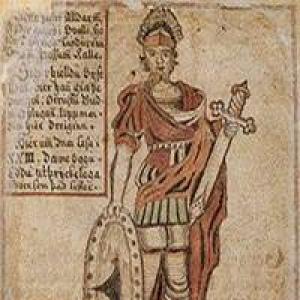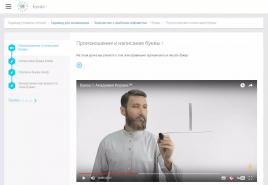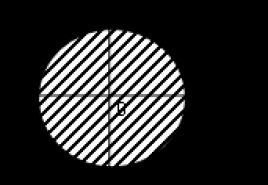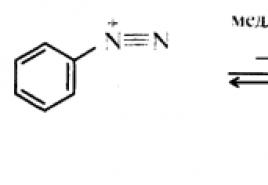Headdresses of Napoleon's dragoons. Military costume: Napoleon's famous cocked hat What kind of headdress did Napoleon wear?
representative of the International Napoleonic Society in Russia
THE RIDDLE OF NAPOLEON'S EIGHT HATS
The most common headdress in French XVIII Army century there was a hat made of black felt, which was an ordinary round hat with a brim curved up on three sides. This is the well-known cocked hat. By the end of the century, the “horn of the hat” (protruding forward) acute angle) practically disappeared, and the lateral fields, on the contrary, lengthened. The brim, held in place by hooks or leather loops, now rose steeply, with the front brim being lower than the back. By the end of the Empire (1815) some hats were quite bulky, i.e. and wide and tall, which made their owners tall people. On the left side of the front field there was a buttonhole in the form of a braid, which was sewn at the top to the outer edge of the hat, and at the bottom fastened with an army button. A cockade was attached to the upper part of the braid. Behind the cockade there was a small bracket for attaching a pompom or plume of feathers. The outer edges of the hats were trimmed with colored piping or fluffy fringe made of gold or silver threads. The manner of wearing a hat was very important and, although it largely depended on the imagination and tastes of its owner, as well as fashion trends, one thing remained unchanged - before a battle the hat was always worn so that the corners were above the shoulders, but on a march or campaign it allowed to rotate 90 degrees.
However, the entire period of the Empire's history is symbolized by just one hat. You guessed which one. Yes, this is Napoleon's "little hat". It’s a hat, not a cocked or bicorne hat. Such terms did not exist in the era of the Empire. It should be noted that the hat did not correspond to the uniform of any of the units of the French army and was the personal “know-how” of the emperor. The cut of this world-famous headdress has its roots in late XVIII century. This is exactly the hat that young Bonaparte wore when he was a pupil of Brienne. military school. The model of Napoleon's hat remained virtually unchanged over the years (it only became taller and somewhat narrower) and the first designer of his own hat was Napoleon himself. The headdress was made of black felt and had minimal decoration - a three-color cockade attached to a black silk braid. The Emperor wearing such a hat was first depicted in a portrait by the artist Isabé, dating back to 1802.
Napoleon's hatter during the Empire was M. Poupard. He supplied the Emperor with hats at a cost of 48 francs apiece. It is known that during the period from March to December 1807, Napoleon had 12 hats, of which 8 were new and 4 were repaired old ones. In a fit of anger, Napoleon sometimes threw his hat on the floor and trampled on it, as happened, for example, during a meeting with the Austrian envoy Metternich in 1813. But when the anger subsided, he always picked it up. A lesser known fact is that during campaigns or on the march, Napoleon wore a velvet cap, the prototype of the modern cap.
During the campaign in Russia, in 1812, the emperor wore his famous “little hat”, but only on the way from Paris to Moscow, and at the insistence of the chief surgeon Great Army Jean-Domenique Larrey's hat was insulated with woolen fabric from the inside in case of severe frosts. This hat has survived to this day and is in the personal collection of Dr. Ben Weider, a famous Canadian historian and world-famous businessman, author of a number of books on the study of the life and especially the mystery of the death of Napoleon, who kindly agreed to provide a photograph of the famous Napoleon hat for our publication.
The emperor wore this hat on the Borodino field, in which he entered the defeated Russian capital. Napoleon left Moscow wearing the same hat on October 19, 1812.
However, he did not stay there for long. With the onset of severe frosts, he was already seen in a Russian boyar fur coat and hat. This rare moment in history was captured for us by the great Russian artist V.V. Vereshchagin.
But let's return to the riddle of Napoleon's eight hats.
The famous artist Charles de Steuben managed to depict Napoleon's entire life by arranging his hats in different ways. This peculiar charade allows you to read all the glorious and tragic moments of the history of the First Empire without showing the emperor himself. The painting was painted at a time when the restored monarchy of Louis XVIII was very worried about the place it occupied little corporal in the hearts of the French people.
Here's the solution. The first three hats in the top row symbolize the two Italian campaigns and the expedition to Egypt. Three hats in the second row - the empire, its birth, dawn and sunset. The last two are Waterloo and a link to Fr. St. Helena.
By the way, on the island of St. Helena, Napoleon also wore hats, sometimes very funny. But more on that next time.
Published in the Library of the Internet project “1812” with the kind permission of the author.
V. Vereshchagin. Napoleon and Marshal Lauriston.
"He is wearing a triangular hat and a gray field coat..." M. Lermontov
Personal belongings of Napoleon Bonaparte. Army Museum of the Invalides' Home. Paris.
The frock coat is in place and the hat is indeed triangular. But not a cocked hat, but rather a two-cornered hat. It's all about the number of ends of the fields curved towards the crown.
Cocked hat.
A cocked hat is a hat with the brim curved so that it forms three corners. It became widespread in the second half of the 18th century.

Cocked hat

Portrait of Emperor Frederick II.
In the first half of the 17th century in the armies Western Europe A wide-brimmed hat was common. The wide brim prevented the military from throwing back their heads and were a hindrance when a bulky gun was lying on their shoulder.

The edges of the hat were gradually bent until a fundamentally new, progressive style appeared - with three curved brims.
Tricorne distribution - tricorne in the army dates back to the reign of Louis XIV.

A.F. van der Meulen. Equestrian portrait of Louis XIV.

F. Rokotov. Portrait of Peter the Third in knightly armor.

Emperor Paul the First.
Of course, civilians also picked up this fashion.
F. Rokotov. Portrait of an unknown man in a cocked hat.

Fra Vittore Ghislandi. Noble gentleman in gray. The hat is made of black felt and decorated with gold braid.

Portrait of Friedrich Wilhelm von Seydlitz (detail). The decoration of feathers - mostly ostrich - on the edges of a three-cornered hat was called a plume in the 18th century.

William Hogarth, Lower House. Copper engraving.

Pirate cocked hat
Triangular hats were decorated with braid and feathers. Galun or braid—gold, silver or tinsel (copper, tin) braid. Sometimes gold-woven ribbon, bandage, trim, trim. The main material was twisted yarn or, most often, wrapped with a thinner and more beautiful thread. So, silk, linen or paper yarn is wrapped with gold and silver (real or tinsel) threads, silk - linen and paper, wool - paper. Three-cornered hats were adorned on heads until bulky wigs called allonges came into fashion.

After this, civilians wore a cocked hat under their elbow and used it when bowing, describing intricate figures with it.
The cocked hat was part of the hunting suit. In the first half of the 18th century, women willingly wore a cocked hat.

Portrait of Countess Fosse.
In the army, the tricorne took root as the main headdress and was in use until the appearance of the bicorne hat at the end of the 18th century.
Bicorne.
Gradually, the “three corners” became not too compact. In the army, and then among the civilian population, the double-cornered hat became popular. The double-cornered hat folded easily and took up less space - important qualities, especially since gentlemen did not part with their hats at receptions and balls.

French naval officer's bicorne hat. Early 19th century.


D. Doe. Portrait of Emperor Alexander the First.

A. Safonov. Battle of Borodino.

A. Shepelyuk. Kutuzov during the Battle of Borodino. The officers of the retinue wear bicorne hats.
In Russia at the beginning of the last century it was called Wellington. Along with the shako, the bicorne hat was a common headdress for officers in the Russian army from 1803 to 1845. The ranks were distinguished by the width and style of the braid on the sides of the hat, by the cockade and plume. In the portrait of Adjutant General Prince A.S. Menshikov (great-grandson of an associate of Peter I) by D. Doe (1826), he is depicted in a bicorne with a general’s plume of black, orange and white rooster feathers.
D. Doe. Portrait of A.S. Menshikov.
Worn at an angle forward, “in the field,” it indicates that its owner is a member of the imperial retinue. It was also worn by adjutants, General Staff officers, and engineers. In Russia, before the First World War, the bicorne hat was part of the ceremonial clothing of officials.

Bicorne hat of a Russian official.
In some countries, the bicorne hat has been preserved to this day in the uniform of military and diplomats.

Francisco de Goya, Duke Fernand Nunez. National Prado Museum, Madrid. Double-cornered hat decorated with feathers.

F. Goya. Mahi on the balcony. On the cavaliers the swing is typical bicorne.
Napoleon's hat.
Now it's time to return directly to Napoleon's hat. This is not a cocked hat, but it is not a typical bicorne hat either. This is what historian A. Zotov writes about her.
"... the entire period of the empire's history is symbolized by just one hat.

Napoleon's hat, which he wore during the 1812 campaign in Russia, from the collection of B. Vader.
You guessed which one. Yes, this is Napoleon's "little hat". It’s a hat, not a cocked or bicorne hat. Such terms did not exist during the imperial era. It should be noted that the hat did not correspond to the uniform of the French army units and was the personal “know-how” of the emperor. The cut of this world-famous headdress dates back to the end of the 18th century. This is exactly the hat that young Bonaparte wore as a student of the Brienne military school. The model of Napoleon's hat remained virtually unchanged over the years (it only became taller and somewhat narrower), and he was the first designer of his own hat. The headdress was made of black felt and had a minimum of decoration: a three-color cockade attached to a black silk braid. The Emperor wearing such a hat was first depicted in a portrait by the artist Isabé, dating back to 1802.
Napoleon's hatter during the imperial period was M. Poupard. He supplied the emperor with hats at a price of 48 francs apiece. It is known that during the period from March to December 1807, Napoleon had 12 hats, of which 8 were new and 4 were repaired old ones. In a fit of anger, Napoleon sometimes threw his hat on the floor and trampled on it, as happened, for example, during a meeting with the Austrian envoy Metternich in 1813. But when the anger subsided, he always picked it up. A lesser known fact is that during campaigns or on the march, Napoleon wore a velvet cap (the prototype of the modern cap).

V. Vereshchagin. At the stage - bad news from France.
During the campaign in Russia in 1812, Napoleon wore his famous “little hat”, but only on the way from Paris to Moscow. Moreover, at the insistence of the chief surgeon of the great army, Jean-Dominique Larrey, the emperor’s hat was insulated from the inside with woolen fabric in case of severe frosts. This hat has survived to this day and is in the personal collection of Dr. Ben Weider, a renowned Canadian historian. The emperor wore this hat on the Borodino field, and in it he entered the Russian capital. Napoleon left Moscow wearing the same hat on October 19, 1812.
However, he did not wear it for a long time. With the onset of severe frosts, he was already seen in a Russian boyar fur coat and hat.
The famous artist, Charles de Steuben, managed to depict Napoleon's entire life by arranging his hats in different ways. This peculiar charade allows you to read all the glorious and tragic moments of the history of the first empire, without showing the emperor himself

Here's the solution. The first three hats in the top row symbolize the two Italian campaigns and the expedition to Egypt. Three hats in the second row - the empire, its birth, dawn and sunset. The last two are Waterloo and exile to St. Helena.
By the way, on the island of St. Helena, Napoleon also wore hats, sometimes very funny ones."
Fragments of A. Zotov’s article “The Mystery of Napoleon’s Eight Hats” were used, materials from Wikipedia, Internet Project 1812 and sites:
www.1812.ru
www.napoleon ineast.ru/main/article… napoleon a
http://www.russianmontreal.ca/index.
THE RIDDLE OF NAPOLEON'S EIGHT HATS The most common headdress in the French army of the 18th century was a hat made of black felt, which was an ordinary round hat with brims curved up on three sides. This is the well-known cocked hat. By the end of the century, the “horn of the hat” (the sharp corner protruding forward) practically disappeared, and the side brims, on the contrary, lengthened. The brim, held in place by hooks or leather loops, now rose steeply, with the front brim being lower than the back. By the end of the Empire (1815) some hats were quite bulky, i.e. and wide and tall, which made their owners tall people. On the left side of the front field there was a buttonhole in the form of a braid, which was sewn at the top to the outer edge of the hat, and at the bottom fastened with an army button. A cockade was attached to the upper part of the braid. Behind the cockade there was a small bracket for attaching a pompom or plume of feathers. The outer edges of the hats were trimmed with colored piping or fluffy fringe made of gold or silver threads. The manner of wearing a hat was very important and, although it largely depended on the imagination and tastes of its owner, as well as fashion trends, one thing remained unchanged - before a battle the hat was always worn so that the corners were above the shoulders, but on a march or campaign it it was allowed to rotate 90 degrees. However, the entire period of the history of the Empire is symbolized by just one hat. You guessed which one. Yes, this is Napoleon's "little hat". It’s a hat, not a cocked or bicorne hat. Such terms did not exist in the era of the Empire. It should be noted that the hat did not correspond to the uniform of any of the units of the French army and was the personal “know-how” of the emperor. The cut of this world-famous headdress dates back to the end of the 18th century. This is exactly the hat that young Bonaparte wore as a student of the Brienne military school. The model of Napoleon's hat remained virtually unchanged over the years (it only became taller and somewhat narrower) and the first designer of his own hat was Napoleon himself. The headdress was made of black felt and had minimal decoration - a three-color cockade attached to a black silk braid. The Emperor wearing such a hat is first depicted in a portrait by the artist Isabet, dating from 1802. Monsieur Poupard was Napoleon's hatter during the Empire. He supplied the Emperor with hats at a cost of 48 francs apiece. It is known that during the period from March to December 1807, Napoleon had 12 hats, of which 8 were new and 4 were repaired old ones. In a fit of anger, Napoleon sometimes threw his hat on the floor and trampled on it, as happened, for example, during a meeting with the Austrian envoy Metternich in 1813. But when the anger subsided, he always picked it up. A lesser known fact is that during campaigns or on the march, Napoleon wore a velvet cap, the prototype of the modern cap. During the campaign in Russia, in 1812, the emperor wore his famous “little hat”, but only on the way from Paris to Moscow , and at the insistence of the chief surgeon of the Grand Army, Jean-Domenique Larrey, the emperor’s hat was insulated from the inside with woolen fabric in case of severe frosts. This hat has survived to this day and is in the personal collection of Dr. Ben Weider, a famous Canadian historian and world-famous businessman, author of a number of books on the study of the life and especially the mystery of the death of Napoleon, who kindly agreed to provide a photograph of the famous Napoleon hat for our publication. Napoleon's hat, which he wore during the 1812 campaign in Russia (from the collection of Dr. Ben Weider) The emperor wore this hat on the Borodino field, in which he entered the defeated Russian capital. Napoleon left Moscow wearing the same hat on October 19, 1812. ================ Archived topic ♚CLOTHING FOOTWEAR ACCESSORIES♚ . ALBUMS: (enter CLOTHES in the photo album search engine - by clicking a number of albums will pop up) CLOTHING for DOLLS SHOES for DOLLS - HAT WEARS for dolls
The military hat that fell from Napoleon Bonaparte's head on the battlefield when the commander fled defeat at the Battle of Waterloo in 1815 was, the site reports. The collector who purchased the legendary bicorne paid a very impressive amount for it.
Napoleon Bonaparte's bicorne hat was sold at auction
It is known that the legendary French emperor and commander Napoleon Bonaparte was very fond of bicorne hats. The military leader put them on with corners to the sides, so the military could distinguish him on the battlefield. It is believed that his collection included more than 120 hats. Many of them were sold to private collections. But today only 19 Napoleon bicornes have survived.
 Photo: bbc.com
Photo: bbc.com The other day in Lyon, France, Napoleon's most famous bicorne went under the hammer. It was here that the Emperor of France fought his last major battle at Waterloo. The collector who purchased the commander's hat paid $325,000 for it.
An employee of the auction house that conducted the auction said that the bicorne was sold to a private collection. It was on that day on which 203 years ago the legendary battle at Waterloo.

Interestingly, Napoleon Bonaparte's items often become auction lots and are highly prized by collectors. For example, brightly, which was worn by the emperor before the famous battle, is in the possession of royal family Britain.
The legendary bicorne hat previously belonged to another private collector, who acquired it in 1986. Auction house employees say the hat is not in the best condition. But they believed that they would buy it for no less than forty thousand euros.

Historians say that Napoleon’s bicorne hat was picked up on the battlefield by the captain of the Dutch army, Baron Arnout Jacques van Zeilen van Nijvelt. Later she visited several private collections and has now found a new owner.
Sometimes very interesting things are put up for auction. For example, the famous American inventor Steve Jobs recently went under the hammer. Archival document sold for more than 3 times the starting amount.








